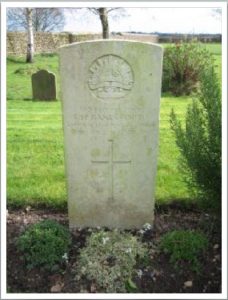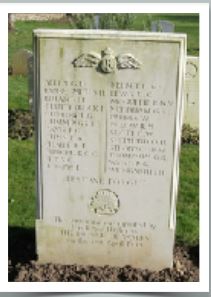8th Training Squadron, Australian Flying Corps

Sydney Harold Banks-Smith was born at Cundletown, near Taree, New South Wales (NSW) in 1892, the son of Harold and Florence Banks-Smith.
Harold died in 1897 and in 1902, Florence remarried to become Mrs Lodge, living at Nelson Street, Gordon, NSW. She was down as Sydney’s next of kin.
After being educated at Sydney Grammar School, Sydney’s military career began at Queen’s Park in NSW on 30 March 1915, when he joined the 5th Field Ambulance.
His civilian occupation was stated as a ‘mechanic, engines’ and he had spent 18 months as an apprentice at Morts Dock.
On 31 May 1915 he embarked from Sydney aboard the troopship Ajana, with ‘A’ Section of the 5th Field Ambulance and by 16 August 1915 he had joined the ANZAC forces at Gallipoli.
Indiscipline was a feature of Sydney’s entire military career. On 28 October 1915 charges of neglecting duty and being insolent to a NCO were upheld, resulting in seven days Field Punishment No 2 and stoppage of pay.
Following the evacuation of Gallipoli, he arrived at Alexandria on 9 January 1916 and on 24 February he transferred to 15th Field Ambulance at the main Australian camp in Egypt, Tel-el-Kabir. It was not long before he was in trouble again, being absent from duty on two occasions and once again he received a Field Punishment No 2 and a stoppage of pay.
On 4 May 1916 he was posted to 5th (Australian) Division HQ, probably as a driver. On the 17th of that month he sailed from Alexandria aboard the troopship Transylvania, bound for Marseilles arriving on 26 June. He remained on the Western Front for almost five months, before taking a train from Albert to Le Havre on 5 November 1916 and thence to England by ship, where he reported to the Australian Imperial Force (AIF) HQ at 130 Horseferry Road, Westminster, London.
On 16 November 1916 he reported to No 1 Royal Flying Corps (RFC) Officers’ Cadet Battalion at Denham, Buckinghamshire, with a view to becoming an officer in the RFC. After a stay of about six weeks, on 26 January 1917, he arrived at the School of Military Aeronautics, Exeter College, Oxford. Unfortunately another incidence of indiscipline, on 11 February 1917, brought his hopes of a commission in the RFC to an end.
On 7 March 1917 he appeared before a District Court Martial in Oxford charged with drunkenness and resisting arrest.
He pleaded guilty to both charges and was sentenced to 14 days detention and the forfeiture of 38 days pay. He was no longer considered suitable to hold a commission in the RFC and was ordered to the AIF Draft Depot at Perham Down, Wiltshire, with a recommendation that it be ‘considered preferable he be attached to an infantry unit’.
From Perham Down he was sent, via Folkestone, across the Channel to the vast British Expeditionary Force training base at Etaples, arriving on 11 April 1917. Somehow he managed to avoid a posting to the infantry and on 26 April he was back with the 5th (Australian) Division HQ, joining the ‘K’ Supply Column on 1 May. A period of attachment with 8th Australian Field Artillery may have followed (his service record is not clear) before, on 6 August 1917, he managed to fix a transfer to the Australian Flying Corps (AFC) Training Depot at Farnborough, as a driver, with the rank of Air Mechanic Second Class.
From Farnborough he was sent to the AFC Training Depot at Halton Camp, Wendover, Buckinghamshire, prior to a posting to 29th Training Squadron, Shawbury, Shropshire on 9 November. His stay there was interrupted by a short spell at the Armament School, Perivale, Middlesex, prior to joining 5th Training Squadron on 28 January 1918.
He was then due to go overseas being posted back to Halton Camp on 17 February but eventually remained in the UK, following a posting to 8th Training Squadron at Leighterton, Gloucestershire.
On 17 March 1918 he was up before his CO again, having been charged that he had neglected to obey an order on 7 March and displayed conduct to the prejudice of good order and military discipline. His punishment was the forfeiture of five days’ pay. Notwithstanding his poor disciplinary record, he was made up to Air Mechanic First Class, with 8th Training Squadron on 1 June 1918.
Air Mechanics did get opportunities to undertake flights, as passengers. On 3 July 1918 Sydney was taken up from Leighterton Airfield in a RE8 machine (serial no E140), piloted by the experienced Lieutenant George Robert Thompson, of 7th Training Squadron. Neither the Banks-Smith, nor the Thompson, service papers provide much detail as to the circumstances of the accident, in which both men lost their lives. It would appear that Lieutenant Thompson had taken the RE8 into a dive onto a practice target when it either caught fire or crashed and burst into flames upon impact.
Sydney Banks-Smith was discovered in the wrecked machine dead from a fractured skull and badly burnt. At the age of 26 his colourful and varied service career was at an end.
A CWGC headstone marks his grave where he was buried in Leighterton Church Cemetery along with Lieutenant Thompson and he is also commemorated on the Sydney Grammar School Roll of Honour.
Researched by Graham Adams 10 January 2018


